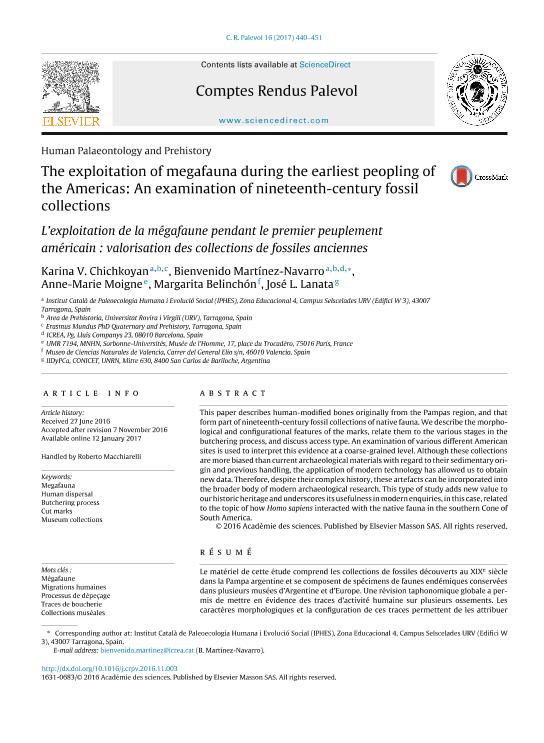Mostrar el registro sencillo del ítem
dc.contributor.author
Chichkoyan, Karina Vanesa

dc.contributor.author
Martínez Navarro, Bienvenido
dc.contributor.author
Moigne, Anne Marie
dc.contributor.author
Belinchón, Margarita
dc.contributor.author
Lanata, Jose Luis

dc.date.available
2018-09-04T19:23:30Z
dc.date.issued
2017-06
dc.identifier.citation
Chichkoyan, Karina Vanesa; Martínez Navarro, Bienvenido; Moigne, Anne Marie; Belinchón, Margarita; Lanata, Jose Luis; The exploitation of megafauna during the earliest peopling of the Americas: An examination of nineteenth-century fossil collections; Elsevier Masson; Comptes Rendus Palevol; 16; 4; 6-2017; 440-451
dc.identifier.issn
1631-0683
dc.identifier.uri
http://hdl.handle.net/11336/58273
dc.description.abstract
This paper describes human-modified bones originally from the Pampas region, and that form part of nineteenth-century fossil collections of native fauna. We describe the morphological and configurational features of the marks, relate them to the various stages in the butchering process, and discuss access type. An examination of various different American sites is used to interpret this evidence at a coarse-grained level. Although these collections are more biased than current archaeological materials with regard to their sedimentary origin and previous handling, the application of modern technology has allowed us to obtain new data. Therefore, despite their complex history, these artefacts can be incorporated into the broader body of modern archaeological research. This type of study adds new value to our historic heritage and underscores its usefulness in modern enquiries, in this case, related to the topic of how Homo sapiens interacted with the native fauna in the southern Cone of South America.
dc.description.abstract
Le matériel de cette étude comprend les collections de fossiles découverts au XIXe siècle dans la Pampa argentine et se composent de spécimens de faunes endémiques conservées dans plusieurs musées d’Argentine et d’Europe. Une révision taphonomique globale a permis de mettre en évidence des traces d’activité humaine sur plusieurs ossements. Les caractères morphologiques et la configuration de ces traces permettent de les attribuer à des étapes du processus de boucherie. Ces collections fossiles souffrent, plus que tout autre matériel archéologique, de nombreux biais liés à leur origine sédimentaire et à leur historique. Néanmoins, les observations microscopiques et l’étude des traces à partir des données de scanner surfaciques ont permis d’argumenter et de confirmer ces interprétations. Malgré leur histoire compliquée, ces collections peuvent ainsi être intégrées à un corpus archéologique et étudiées selon ce nouvel axe de recherche. Ce type d’étude permet de revaloriser un patrimoine historique en montrant l’intérêt de ces collections dans des problématiques actuelles telles que la question de l’interaction d’Homo sapiens avec les mégafaunes endémiques du cône austral d’Amérique du Sud.
dc.format
application/pdf
dc.language.iso
eng
dc.publisher
Elsevier Masson

dc.rights
info:eu-repo/semantics/openAccess
dc.rights.uri
https://creativecommons.org/licenses/by-nc-nd/2.5/ar/
dc.subject
Butchering Process
dc.subject
Cut Marks
dc.subject
Human Dispersal
dc.subject
Megafauna
dc.subject
Museum Collections
dc.subject.classification
Paleontología

dc.subject.classification
Ciencias de la Tierra y relacionadas con el Medio Ambiente

dc.subject.classification
CIENCIAS NATURALES Y EXACTAS

dc.title
The exploitation of megafauna during the earliest peopling of the Americas: An examination of nineteenth-century fossil collections
dc.title
L’exploitation de la mégafaune pendant le premier peuplement américain : valorisation des collections de fossiles anciennes
dc.type
info:eu-repo/semantics/article
dc.type
info:ar-repo/semantics/artículo
dc.type
info:eu-repo/semantics/publishedVersion
dc.date.updated
2018-09-04T18:35:55Z
dc.journal.volume
16
dc.journal.number
4
dc.journal.pagination
440-451
dc.journal.pais
Francia

dc.journal.ciudad
Paris
dc.description.fil
Fil: Chichkoyan, Karina Vanesa. Universitat Rovira i Virgili. Institut Català de Paleoecologia Humana i Evolució Social; España. Consejo Nacional de Investigaciones Científicas y Técnicas; Argentina
dc.description.fil
Fil: Martínez Navarro, Bienvenido. Universitat Rovira i Virgili. Institut Català de Paleoecologia Humana i Evolució Social; España. Institució Catalana de Recerca i Estudis Avancats; España
dc.description.fil
Fil: Moigne, Anne Marie. Musée de l’Homme; Francia
dc.description.fil
Fil: Belinchón, Margarita. Museo de Ciencias Naturales de Valencia; España
dc.description.fil
Fil: Lanata, Jose Luis. Consejo Nacional de Investigaciones Científicas y Técnicas. Centro Científico Tecnológico Conicet - Patagonia Norte. Instituto de Investigaciones en Diversidad Cultural y Procesos de Cambio. Universidad Nacional de Río Negro. Instituto de Investigaciones en Diversidad Cultural y Procesos de Cambio; Argentina
dc.journal.title
Comptes Rendus Palevol

dc.relation.alternativeid
info:eu-repo/semantics/altIdentifier/doi/http://dx.doi.org/10.1016/j.crpv.2016.11.003
dc.relation.alternativeid
info:eu-repo/semantics/altIdentifier/url/https://www.sciencedirect.com/science/article/pii/S1631068316301270
Archivos asociados
